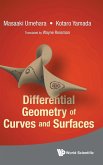A TREATISE ON THE DIFFERENTIAL GEOMETRY OF CURVES AND SURFACES. PREFACE: This book is a development from courses which I have given in Princeton for a number of years. During this time I have come to feel that more would be accomplished by my students if they had an introductory treatise written in English and otherwise adapted to the use of men beginning their graduate work. Chapter I is devoted to the theory of twisted curves, the method in general being that which is usually followed in discussions of this subject. But in addition I have introduced the idea of moving axes, and have derived the formulas pertaining thereto from the previously obtained Freiiet-Serret fornmlas. In this way the student is made familiar with a method which is similar to that used by Darboux in the tirst volume of his Lepons, and to that of Cesaro in his Gcomctria Ittiriiiseca. This method is not only of great advantage in the treat ment of certain topics and in the solution of problems, but it is valu able iu developing geometrical thinking. The remainder of the book may be divided into threo parts. The iirst, consisting of Chapters II-VI, deals with the geometry of a sur face in the neighborhood of a point and the developments therefrom, such as curves and systems of curves defined by differential equa tions. To a large extent the method is that of Gauss, by which the properties of a surface are derived from the discussion of two qxiad ratie differential forms. However, little or no space is given to the algebraic treatment of differential forms and their invariants. In addition, the method of moving axes, as defined in the first chapter, has been extended so as to be applicable to an investigation of the properties of surf ac. es and groups of surfaces. The extent of the theory concerning ordinary points is so great that no attempt has been made to consider the exceptional problems. Por a discussion of uch questions as the existence of integrals of differential equa tions and boundary conditions the reader must consult the treatises which deal particularly with these subjects. lu Chapters VII and VIII the theory previously developed is applied to several groups of surfaces, such as the quadrics, ruled surfaces, minimal surfaces, surfaces of constant total curvature, and surfaces with plane and spherical lines of curvature The idea of applicability of surfaces is introduced in Chapter IIT as a particular case of conformal representation, and throughout the book attention is called to examples of applicable surfaces. However, the general problems concerned with the applicability of surfaces are discussed in Chapters IX and X, the latter of which deals entirely with the recent method of Weingarten and its developments. The remaining four chapters are devoted to a discussion of infinitesimal deformation of surfaces, congruences of straight Hues and of circles, and triply orthogonal systems of surfaces. It will be noticed that the book contains many examples, and the student will find that whereas certain of them are merely direct applications of the formulas, others constitute extensions of the theory which might properly be included as portions of a more ex tensive treatise. At first I felt constrained to give such references as would enable the reader to consult the journals and treatises from which some of these problems were taken, but finally it seemed best to furnish, no such key, only to remark that the flncyklopadie der mathematisc7ien Wissensckaften may be of assistance. And the same may be said about references to the sources of the subject-matter of the book. Many important citations have been made, but there has not been an attempt to give every reference. However, I desire to acknowledge niy indebtedness to the treatises of Uarboux, Biancln, and Scheffers...








